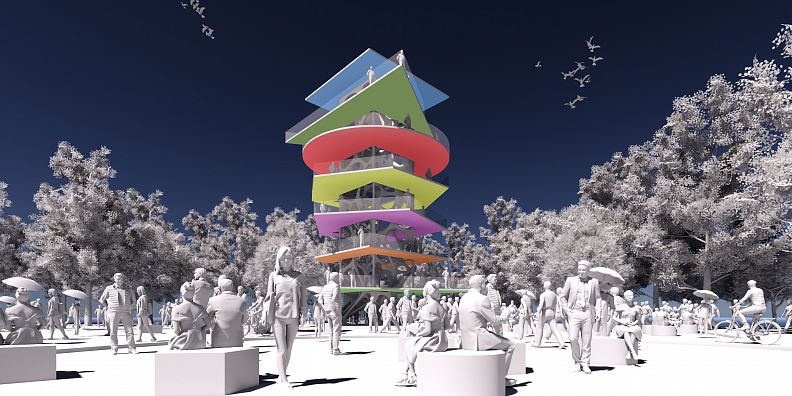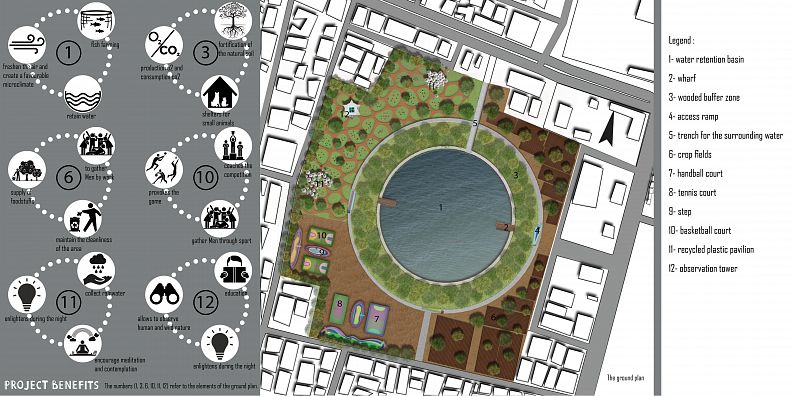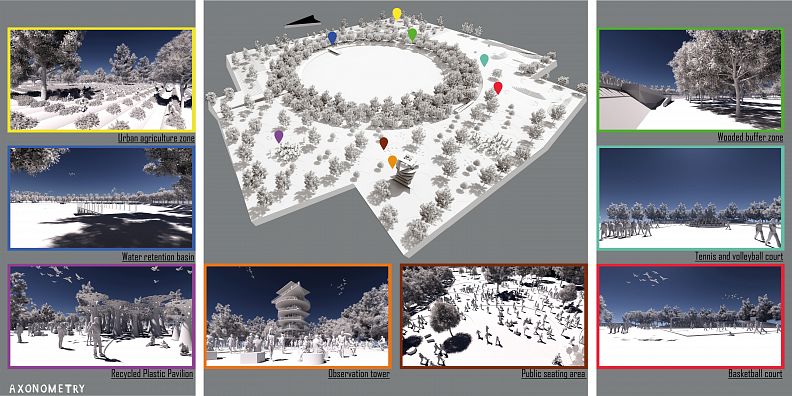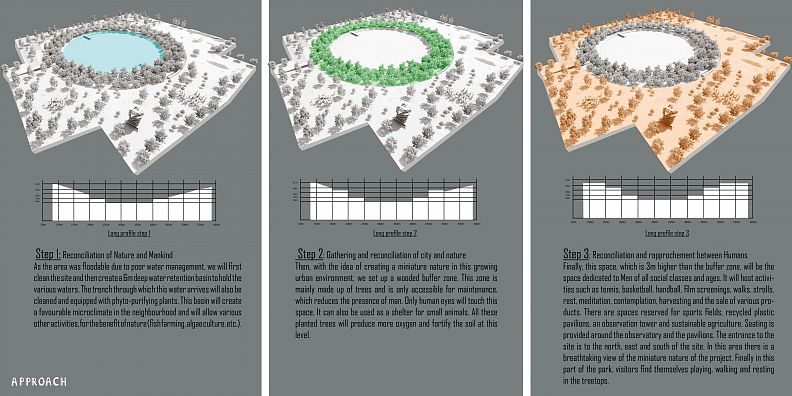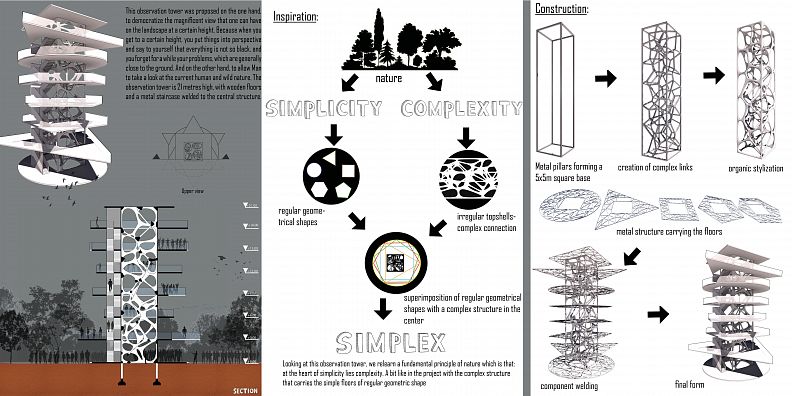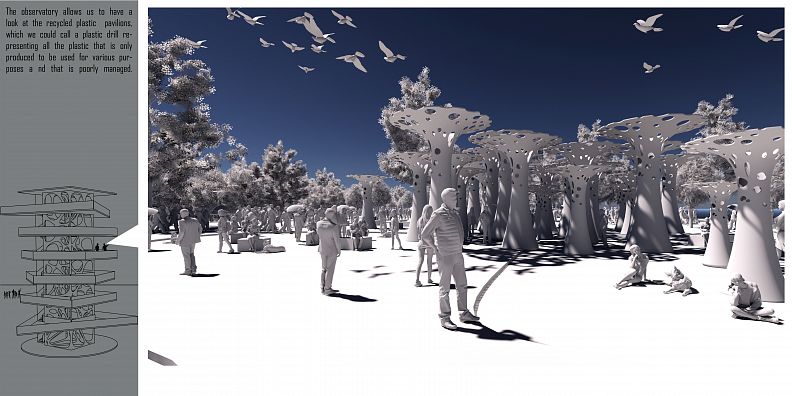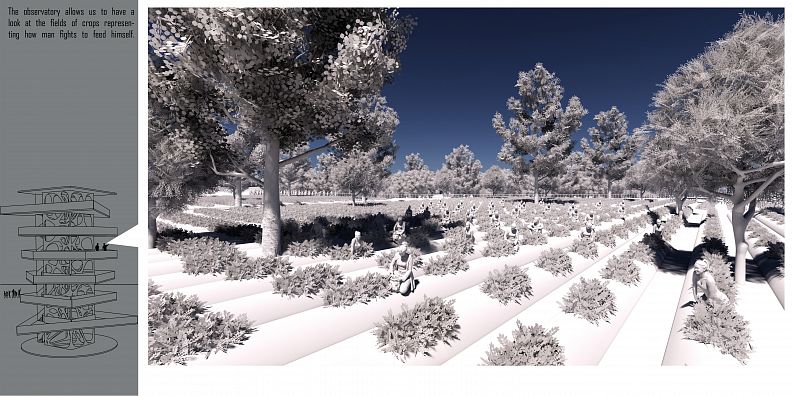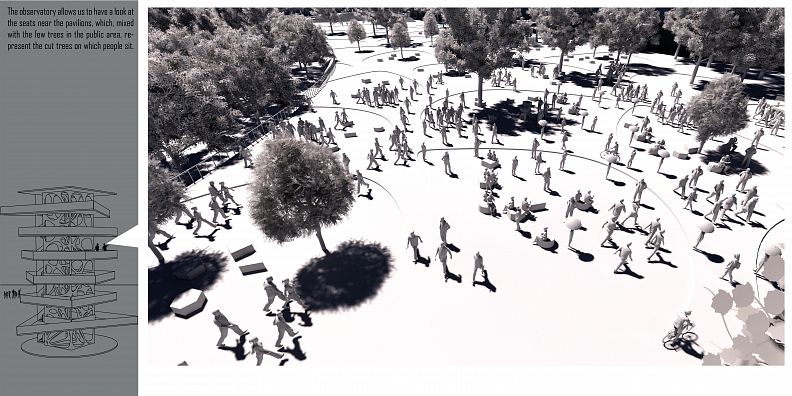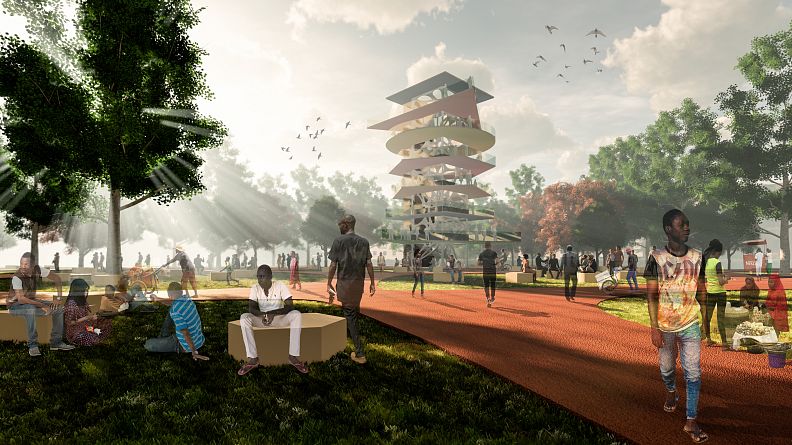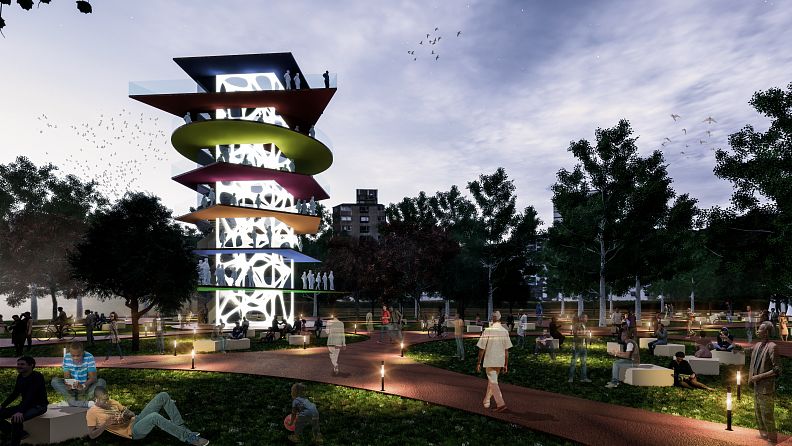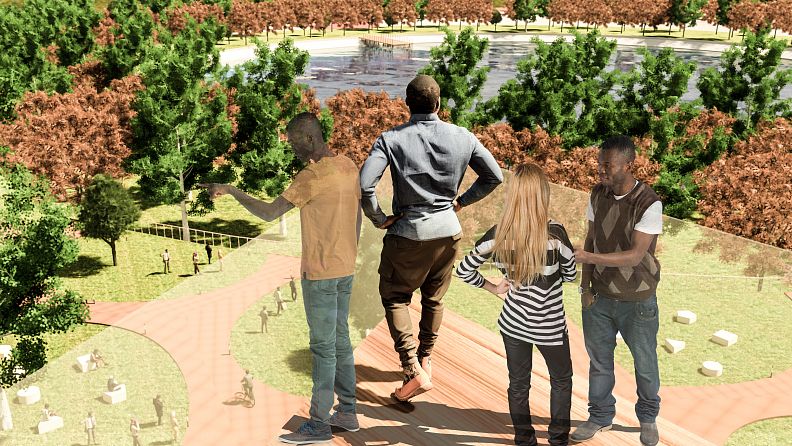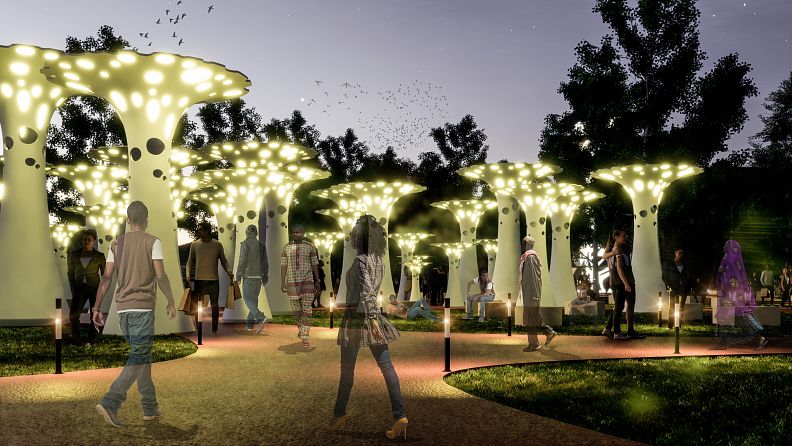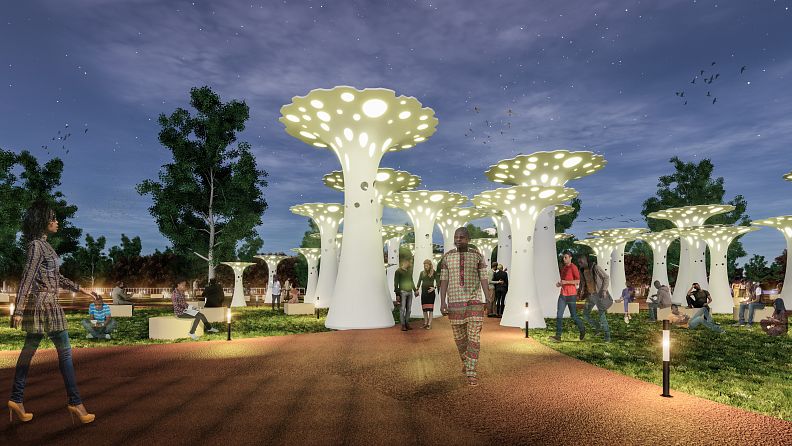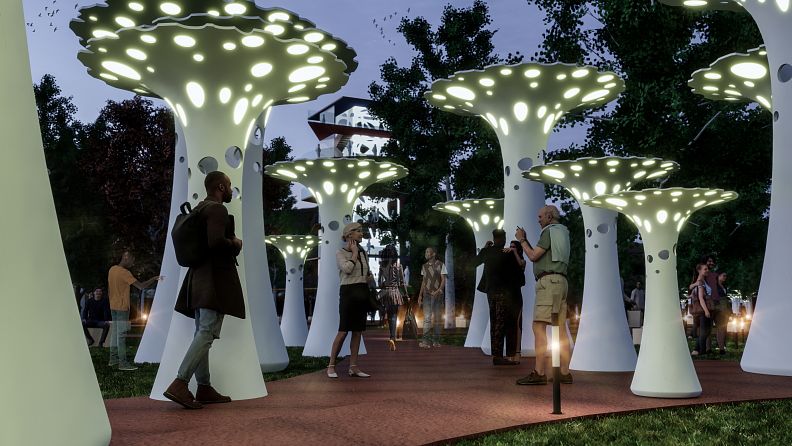Simplex Park : A look at nature

Project idea
Would reducing urban voids through public green spaces reduce the void that is gradually being created on the one hand between Humans and on the other hand between Humans and nature? We asked ourselves this question during the operational urban planning workshop of semester 7, whose theme was "Redevelopment of the Togo 2000 fairgrounds and its surroundings in the commune of Bè-centre of Greater Lomé". After field visits, surveys among the inhabitants of the area and taking photographs, we were able to identify the negative energy emanating from urban voids in general and from the one located near the Togo 2000 fair in particular. Indeed, this abandoned space attracts in the area, floods during the rainy season destroying houses on its way, insecurity due to the lack of public lighting and a huge deposit of household and plastic waste leading to visual and environmental pollution.
Therefore, in order to answer the question raised above, we must propose a public green space of a particular and rare singularity, which will be able to challenge, gather and reconcile Man and Nature. This is why our project entitled Simplex Park: a look at nature, proposes a series of simple actions (such as the stratification of spaces, the creation of a water basin, reforestation, the creation of a space to practice and initiate urban agriculture in the commune, the recycling and exhibition of plastic waste, the creation of a community space) that have a great impact. Knowing that a good observation precedes a great action, the project stages, like a play, different components of the environment created by man and nature. Thus we meet in the project, one area that represents concrete constructions, another that represents the use of plastic, one that represents deforestation, one that represents the struggle that man has to fight to feed himself... This observation is orchestrated and directed by an observation tower, inspired by the principles of simplicity (regular geometric forms, simple connection) and complexity (irregular geometric forms, complex connection) encountered in nature. This observation tower will be for the Bè commune what the lighthouse is for the port. As the first equipment of its kind in Togo, the observation tower will help to take a step forward in understanding the landscape near and around the study area.
The look is a window to the soul, giving everyone, young and old, rich and poor, men and women, the opportunity to contemplate human nature and the wild nature, this project hopes to generate a collective consciousness, which will lead to change and sustainable development of the Bè commune. At the heart of simplicity lies great complexity.
Project description
Approach:
Step 1: Reconciliation of Nature and Mankind
As the area was floodable due to poor water management, we will first clean the site and then create a 6m deep water retention basin to hold the various waters. The trench through which this water arrives will also be cleaned and equipped with Phyto-purifying plants. This basin will create a favourable microclimate in the neighbourhood and will allow various other activities, for the benefit of nature (fish farming, algae culture, etc.).
Step 2: Gathering and reconciliation of city and nature
Then, with the idea of creating a miniature nature in this growing urban environment, we set up a wooded buffer zone. This zone is mainly made up of trees and is only accessible for maintenance, which reduces the presence of man. Only human eyes will touch this space. It can also be used as a shelter for small animals. All these planted trees will produce more oxygen and fortify the soil at this level.
Step 3: Reconciliation and rapprochement between Humans
Finally, this space, which is 3m higher than the buffer zone, will be the space dedicated to Men of all social classes and ages. It will host activities such as tennis, basketball, handball, film screenings, walks, strolls, rest, meditation, contemplation, harvesting and the sale of various products. There are spaces reserved for sports fields, recycled plastic pavilions, an observation tower and sustainable agriculture. Seating is provided around the observatory and the pavilions. The entrance to the site is to the north, east and south of the site. In this area, there is a breathtaking view of the miniature nature of the project. Finally, in this part of the park, visitors find themselves playing, walking and resting in the treetops.
Observation tower :
This observation tower was proposed, on the one hand, to democratize the magnificent view that one can have on the landscape at a certain height, a view that is usually reserved for a certain class of person. Because when you get to a certain height, you put things into perspective and you say to yourself that everything is not so dark, and it happens that you forget for a while your problems, which are usually close to the ground. And on the other hand, to allow the population of the commune of Bè and even further away from Togo, to observe their environment from another angle and to take the necessary decisions. The observation tower is 21 metres high, with wooden floors and a metal staircase welded to the central structure.
By looking at this observation tower, we relearn a fundamental principle of nature: at the heart of simplicity lies complexity. A bit like in the project with the complex structure that carries the simple floors of regular geometric shape. The colours have been subtly placed under each floor, so that after seeing them, you can't help but smile at this rainbow of colours. Which lights up at night and thus becomes a symbol for the region.
Part of the pavilion:
Given the large amount of plastic waste on the site and its surroundings, we proposed pavilions made of recycled plastic. The openings are made of Plexiglas, combined with a device that produces light at night. In addition, this pavilion has the particularity of collecting rainwater in underground cisterns. The water collected will be used to water the park's green spaces. The height of these structures varies from 1.5 m to 3.5 m. These pavilions take their inspiration from the shape of the fungus, which is a very decisive organism (fungi) in the beginning of life on earth.
The observatory gives a view of the concrete bleachers and the sports field of the project, which could be described as a concrete mountain representing the concrete constructions growing all over the city.
The observatory allows us to observe the recycled plastic pavilions, which could be called a plastic drill representing all the plastic that is produced only to be used for various purposes and is poorly managed.
The observatory allows us to see the seats near the pavilions, which, mixed with the few trees in the public space, represent the cut-down trees on which people sit.
The observatory allows us to see the fields of crops that represent the way man fights for food.
The observatory offers a view of the wooded buffer zone representing a forest of trees.
The observatory offers a view of the water retention basin representing natural watercourses.
The observatory offers a view of nature struggling to restore balance.
Technical information
The construction technique is based on the use of metal. Welded to have the shape you want. The central structure has a square base of 5m on each side and each floor apart from the triangular one can be inscribed within a circle of 7m radius. The handrails are made of polycarbonate and are 1.30m high. Then the pavilions are made of recycled plastic sheets.
The seating at the public area is made of concrete. The material on the ground is essentially earth.
